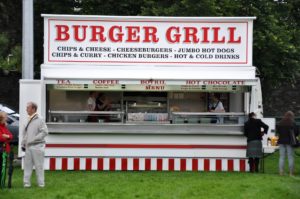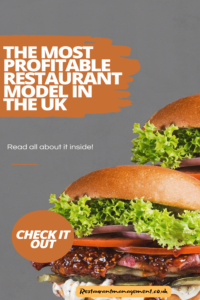First Published: 16 January 2023
Profitable Restaurant Model
Table of Contents
Overview of the UK restaurant industry
The restaurant industry in the United Kingdom is a dynamic and constantly evolving sector. The most profitable restaurant model in the UK right now offers a wide range of cuisine, from fast food to fine dining. The industry offers a diverse array of opportunities for businesses, and according to the most recent market data from Statista, the UK restaurant industry generated turnover amounting to over £$33.7 billion in 2020.
In recent years, several key trends have emerged within the UK restaurant industry. Some of the notable trends include a rise in demand for plant-based and vegan options, an increased focus on sustainability and ethical sourcing, the growth of online and delivery services, and the impact of the COVID-19 pandemic on the industry, with many restaurants having to close or pivot to takeout and delivery.
This article explores these trends and the most successful and profitable restaurant models currently available in the UK market.
UK Restaurant Industry Now
The industry has been affected greatly by the COVID-19 pandemic, leading to a significant decline in sales and the closure of many restaurants. However, the industry has been showing signs of recovery, as the government’s support measures and the reopening of the economy helped to revive the industry.
With the recent developments in the vaccine and the hope of the situation returning to normal, the industry is expected to recover in the next year. The industry is also facing challenges such as Brexit, labour shortages, and an increase in costs.

Profitable Restaurant Models in the UK
What is the best and most profitable restaurant model?
The most profitable restaurant model can vary depending on factors such as location, cuisine, target market, and operational efficiency. However, some successful and profitable restaurant models include:
- Fast Casual:
This model focuses on providing high-quality food in a quick-service setting, often with a focus on fresh and healthy options. This model typically has lower overhead costs than full-service restaurants and can be profitable through a combination of counter service and takeout/delivery.
In the UK market, the average sales, gross profit, and net profit for fast casual restaurants can vary depending on many factors, such as location, menu offerings, and customer demographics. However, according to some industry reports, the average sales for fast casual restaurants in the UK range from £250,000 to £1.5 million per year.
The gross profit margin for fast casual restaurants in the UK can range from 20-40%. This means that if a fast-casual restaurant has £1 million in sales, its gross profit (the revenue remaining after deducting the cost of goods sold) could be anywhere from £200,000 to £400,000.
The net profit margin for fast casual restaurants in the UK can range from 3-8%. This means that if a fast-casual restaurant has £1 million in sales, its net profit (the revenue remaining after deducting all expenses) could be anywhere from £30,000 to £80,000.
It’s important to note that these figures are just estimates, and actual figures can vary widely depending on the specific business and market. It’s important to do your research and consult with industry professionals to get a more accurate picture of the potential financial performance of a fast-casual restaurant in the UK market.
- Fine Dining:
This model is characterized by upscale dining, extensive wine lists, and professional service. Fine dining restaurants often have high ticket prices, which can lead to high profit margins.
Fine dining restaurants often have high ticket prices, which can lead to high profit margins.
Industry reports indicate that average sales for fine dining restaurants in the UK range from £500,000 to £5 million per year.
The gross profit margin for fine dining restaurants in the UK can range from 30-50%. This means that if a fine dining restaurant has £1 million in sales, their gross profit (the revenue remaining after deducting the cost of goods sold) could be anywhere from £300,000 to £500,000.
The net profit margin for fine dining restaurants in the UK can range from 5-15%. This means that if a fine dining restaurant has £1 million in sales, its net profit (the revenue remaining after deducting all expenses) could be anywhere from £50,000 to £150,000.
These figures can vary widely depending on the specific business and market. Fine dining restaurants can have high fixed costs, such as rent, staff, and equipment, which should be taken into consideration when estimating the net profit.

- Speciality restaurants:
This model focuses on a specific cuisine or type of food and can be quite profitable, especially if this profitable restaurant model has a strong reputation for its speciality.
Speciality restaurants can vary depending on many factors, such as location, menu offerings, and customer demographics. However, according to some industry reports, the average sales for speciality restaurants in the UK can range from £200,000 to £3 million per year.
The gross profit margin for speciality restaurants in the UK can range from 25-45%. This means that if a speciality restaurant has £1 million in sales, their gross profit (the revenue remaining after deducting the cost of goods sold) could be anywhere from £250,000 to £450,000.
The net profit margin for speciality restaurants in the UK can range from 5-10%. This means that if a speciality restaurant has £1 million in sales, their net profit (the revenue remaining after deducting all expenses) could be anywhere from £50,000 to £100,000.
Speciality restaurants, just like fine dining, can have high fixed costs, such as rent, staff, and equipment, that should be taken into consideration when estimating the net profit.
- Fast Food Restaurant
In the UK, the average sales, gross profit, and net profit for fast food restaurants can vary depending on many factors, such as location, menu offerings, and customer demographics. However, according to industry reports, the average sales for fast food restaurants in the UK can range from £250,000 to £1.5 million per year.
The gross profit margin for fast food restaurants in the UK can range from 35-55%. This means that if a fast food restaurant has £1 million in sales, their gross profit (the revenue remaining after deducting the cost of goods sold) could be anywhere from £350,000 to £550,000.
The net profit margin for fast food restaurants in the UK can range from 5-10%. This means that if a fast food restaurant has £1 million in sales, their net profit (the revenue remaining after deducting all expenses) could be anywhere from £50,000 to £100,000.
It’s important to note that these figures are just estimates, and actual figures can vary widely depending on the specific business and market. It’s important to do your research and consult with industry professionals to get a more accurate picture of the potential financial performance of a particular profitable restaurant model in the UK market.
Restaurant Profit: How To Make Your Restaurant More Profitable
Other trending restaurant ideas include:
- Ghost Kitchens: Also known as virtual kitchens, these are commercial kitchens that are used solely for the preparation of food to be sold online and delivered rather than served in person at a physical restaurant. Ghost kitchens allow restaurants to expand their reach and improve profitability by reducing the costs of operating a physical location.
- Franchise Model: This model involves a business allowing others to use its name, trademark, and business model in exchange for a fee. This model can be profitable for the franchisor, as they receive a percentage of the franchisee’s revenue, as well as for the franchisee, as they get the benefits of established brand recognition and a proven business model.
- Food Trucks: This model involves a mobile kitchen that can be moved to different locations. This can be a profitable model as it allows the restaurant to reach a wider audience and can be less expensive to operate than a traditional brick-and-mortar location.
- Pop-Up Restaurants: This model is a temporary restaurant that operates for a limited time, often in a unique location or with a unique concept. This can be a profitable model as it allows the restaurant to test new ideas and concepts without the long-term commitment of a traditional location.
All of the above models can be profitable, but it’s important to choose the right one based on your resources, target audience, and location. A combination of models can be a good idea as well, some restaurant owners have both a physical location and food trucks, or a physical location and offer delivery and take-out services.
Ultimately, the most profitable restaurant model for a particular business will depend on a variety of factors such as location, target market, and the specific strengths and capabilities of the business.
Additionally, it’s also important to note that a restaurant’s success depends not only on the model chosen but also on the execution and management of the business. This includes factors such as menu development, effective marketing, and building a strong team. It’s also important to stay current with industry trends and adapt to changes in consumer preferences and behaviour.
Another important factor to consider is the concept of cost-effective management, this includes the cost of ingredients, staff, equipment, and rent. Keeping these costs low will help ensure that the restaurant is profitable.
Finally, it’s crucial to have a solid business plan in place, which includes financial projections, a marketing strategy, and a plan for managing and growing the business. This will help ensure that the restaurant is well-positioned for success and profitability in the long term.

Related articles:
How To Improve Restaurant Profits
Restaurant Management Structure
Current Trends in the UK Restaurant Industry
Currently, several trends are emerging within the UK restaurant industry. Some of the notable trends include:
- Plant-based and vegan options: With an increasing number of customers looking for healthier, more environmentally friendly, and ethically sourced food options, vegan and plant-based options are becoming more popular in the UK.
- Sustainable and ethical sourcing: This trend is driven by consumer demand for more environmentally friendly and ethically sourced food. As a result, restaurants that prioritize these values are gaining popularity among customers who are more conscious of their food choices.
- Online and delivery services: The delivery and takeaway market, driven by the rise of food delivery apps such as Just Eat, Deliveroo, and Uber Eats, has grown significantly in recent years and is expected to continue to grow in the future.
- Ghost kitchens: Ghost kitchens or virtual kitchens, are becoming more popular in the UK, these are commercial kitchens that are used solely for the preparation of food to be sold online and delivered, rather than served in person at a physical restaurant.
- Hybrid Restaurants: Many Restaurants are finding ways to adapt to the current situation by implementing take-out and delivery services, as well as outdoor seating and indoor seating with social distancing measures.
It’s worth noting that these trends are subject to change depending on market conditions and consumer preferences, and businesses need to stay current with these changes to remain competitive and profitable.

What is the fastest-growing restaurant sector in the UK?
Here are the five fastest-growing concepts in the industry right now:
- Fast-casual and casual dining
Fast-casual and casual dining are currently some of the fastest-growing sectors in the UK restaurant industry. These sectors are characterized by an emphasis on high-quality, fresh and healthy options, often at more affordable prices than traditional fine-dining restaurants. Fast-casual restaurants typically offer a wider variety of menu options than fast-food restaurants and typically have a more upscale atmosphere than fast-food restaurants.
Casual dining restaurants are typically full-service restaurants that offer a more relaxed atmosphere and a wider variety of menu options than fast-food restaurants but are less formal than fine-dining restaurants. These sectors are gaining popularity among customers who are looking for a more casual dining experience, and a balance between quality and price.
- Vegan and plant-based options
Vegan and plant-based options are becoming increasingly popular in the UK restaurant industry. This trend is driven by growing consumer interest in healthier, more environmentally friendly, and ethically sourced food options. Vegan and plant-based options are typically free of animal products, including meat, dairy, and eggs.
These options are becoming more mainstream and are no longer considered niche, as more people are becoming conscious of their food choices and health and looking for alternatives to meat-based options. Restaurants that offer a wide variety of vegan and plant-based options are gaining popularity among customers who are looking for more sustainable, healthier, and ethical options. Many restaurants are adding vegan and plant-based options to their menu, and some restaurants are even opening as fully vegan or plant-based, catering to this growing demand.
Restaurant Finance Management: How To Start Generating Awesome Profits
- Food delivery and takeaway market
The food delivery and takeaway market in the UK is a rapidly growing sector. This trend is driven by the rise of food delivery apps such as Just Eat, Deliveroo, and Uber Eats, which make it easy for customers to order food online and have it delivered to their homes or workplaces. These apps have also made it easier for restaurants to expand their reach and improve profitability by reducing the costs of operating a physical location.
The COVID-19 pandemic has also had a significant impact on the food delivery and takeaway market, as many people have been avoiding dining in restaurants and opting for delivery or takeout instead. This has led to an increase in demand for delivery and takeaway services, with many restaurants pivoting to focus on these services to stay afloat during the pandemic.
The food delivery and takeaway market is expected to continue to grow in the future as more and more people become accustomed to the convenience of ordering food online and having it delivered to their homes. This trend is also expected to help many restaurants recover from the economic impact of the pandemic in the future.
- Ghost kitchens
Ghost kitchens, also known as virtual kitchens or cloud kitchens, are becoming more popular in the UK. These are commercial kitchens that are used solely for the preparation of food to be sold online and delivered rather than served in person at a physical restaurant. Ghost kitchens allow restaurants to expand their reach and improve profitability by reducing the costs of operating a physical location.
Ghost kitchens are typically smaller and more cost-effective than traditional restaurants, as they don’t have the overhead costs associated with a physical location, such as rent, utilities, and staffing. Ghost kitchens also allow restaurants to expand their reach beyond their physical location, as they can serve customers in multiple locations through food delivery services.
The COVID-19 pandemic has accelerated the trend of ghost kitchens in the UK, as many restaurants have had to close their physical locations and pivot to delivery and takeaway services to survive. Ghost kitchens provide a way for restaurants to continue to operate and generate revenue during this time.
It’s worth noting that Ghost kitchens are not just for small or new businesses, large chains have also started to invest in ghost kitchens, as a way to increase their delivery and take-out services, and reach new customers.
- Sustainable and ethical sourcing
Sustainable and ethical sourcing is a trend that is gaining momentum in the UK restaurant industry. This trend is driven by consumer demand for more environmentally friendly and ethically sourced food. Restaurants that prioritize these values are gaining popularity among customers who are more conscious of their food choices and the impact of their consumption on the environment and society.
Sustainable sourcing refers to the practice of sourcing ingredients and products to minimise negative impacts on the environment and promote conservation. This may include sourcing ingredients from local farms, using organic and non-GMO products, reducing food waste, and using sustainable packaging.
Ethical sourcing refers to the practice of sourcing ingredients and products in a way that promotes the fair and humane treatment of workers, animals, and the communities that are involved in the supply chain. This may include sourcing ingredients from fair trade providers, promoting animal welfare, and ensuring that workers are treated fairly.
Sustainable and ethical sourcing can help to improve the reputation of a restaurant and attract customers who are looking for more environmentally friendly and ethically sourced food options. It also provides a way for restaurants to differentiate themselves from their competitors and stand out in the market.

Impact of COVID-19 on the UK Restaurant Industry
- Changes in consumer behaviour
The COVID-19 pandemic has significantly impacted the UK restaurant industry, leading to changes in consumer behaviour. One of the most notable changes is the increase in demand for delivery and takeaway services, as many people have been avoiding dining in restaurants and opting for delivery or takeout instead. This has led to increased demand for delivery and takeaway services, with many restaurants focusing on these services to stay afloat during the pandemic.
Additionally, the pandemic has also increased demand for outdoor and indoor seating with social distancing measures, as people want to dine out in a safe and secure environment.
- Increase in home cooking and meal kit delivery
Another change in consumer behaviour is the increase in home cooking and meal kit delivery services, as customers have been looking for ways to replicate restaurant-quality meals at home. This has led to an increase in demand for meal kit delivery services, as well as an increase in demand for online grocery shopping and contactless delivery services.
- Impact on the industry as a whole
Overall, the pandemic has led to significant changes in consumer behaviour, with many people becoming more comfortable with ordering food online and having it delivered to their homes and with cooking at home. These changes in consumer behaviour have had a significant impact on the UK restaurant industry and are expected to continue to shape the industry in the future.
Final recommendations for businesses looking to succeed in the industry
Offer a wide variety of menu options, including plant-based and vegan options, to appeal to customers who are looking for healthier, more environmentally friendly, and ethically sourced food options.
Prioritise sustainable and ethical sourcing, as this can help to improve the reputation of a restaurant and attract customers who are looking for more environmentally friendly and ethically sourced food options.
Consider offering delivery and takeaway services, as this is becoming an increasingly popular way for customers to order food.
Invest in online ordering and delivery platforms, as more and more customers are becoming accustomed to the convenience of ordering food online and having it delivered to their homes.
Focus on the safety of your customers and staff by implementing social distancing measures, contactless payment, and delivery options and ensuring that your establishment follows the guidelines and recommendations from the government and local health authorities.
Create a strong and consistent online presence to attract and retain customers by optimizing your website, social media, and other digital platforms to improve your visibility and credibility.
Keep an eye on the market, consumer preferences, and economic conditions to understand the current state of the restaurant industry and make informed decisions.
Be open to experimentation and try new things to adapt to the market; it could be new dishes, services, formats, ways of engaging with customers, etc.
Invest in your staff, providing them with the necessary skills and tools to deliver exceptional customer service, this will lead to increased customer satisfaction and loyalty.
Finally, stay up to date with the regulations, laws, and compliance, to protect your business and your customers.

What are the tactics used by restaurant owners to increase profitability?
Maximising Revenue: Key Strategies
Now that we’ve explored different restaurant models let’s delve into the strategies for maximising revenue using your chosen model.
- Menu Engineering:
The composition of your menu plays a crucial role in driving sales and profitability. Conduct a thorough analysis of your menu items, identifying high-margin dishes and strategically positioning them to attract customer attention. Consider implementing menu engineering techniques such as highlighting profitable items, adjusting pricing, and leveraging suggestive selling to increase average check size.
- Upselling and Cross-Selling:
Make sure your employees are trained to upsell and cross-sell menu items effectively. Please encourage them to recommend premium upgrades or complementary dishes and beverages that enhance the dining experience. By mastering the art of suggestive selling, your team can simultaneously boost sales and elevate customer satisfaction.
- Beverage Programs:
Take notice of the potential of your beverage offerings to contribute to overall profitability. Develop a curated wine list or craft signature cocktails that complement your cuisine and entice guests to indulge. Implementing creative non-alcoholic options can also cater to health-conscious or designated driver patrons, expanding your customer base and revenue streams.
- Operational Efficiency:
Streamline your operations to minimise waste, optimise inventory management, and reduce labour costs. Invest in technology solutions such as point-of-sale systems and inventory tracking software to enhance efficiency and accuracy. Staff training and workflow optimisation should also be prioritised to maximise productivity and minimise downtime during peak hours.
The Most Profitable Dish: Unveiling the Culinary Cash Cow
While every restaurant has its signature dishes, certain menu items have the potential to generate outsized profits. Let’s uncover the secrets behind the most profitable dish in a restaurant.
The Power of Pasta:
One dish that consistently ranks among the most profitable items on restaurant menus is pasta. With its low-cost ingredients and high perceived value, pasta dishes offer an attractive profit margin for operators. Whether a classic spaghetti marinara or a gourmet lobster ravioli, pasta appeals to a wide range of palates and can be easily customised to fit various dietary preferences.
Seafood Sensations:
Seafood dishes, particularly those featuring salmon or shrimp, are another lucrative option for restaurateurs. While seafood may have a higher initial cost than other proteins, it often commands a premium menu price, allowing for healthy profit margins. From grilled salmon fillets to seafood linguine, incorporating oceanic delights into your menu can reel in profits while delighting seafood-loving diners.
Vegetarian and Vegan Delights:
As plant-based dining continues to gain momentum, vegetarian and vegan dishes present a profitable opportunity for restaurants. Ingredients like quinoa, tofu, and portobello mushrooms can be transformed into delectable entrees that cater to the growing demand for plant-powered options. You can attract health-conscious diners by offering creative and flavorful vegetarian and vegan dishes while boosting your bottom line.
Conclusion
In conclusion, the UK restaurant industry is a diverse and constantly evolving sector, with a wide range of options available to customers. The trends and profitable models in the industry are constantly changing, and businesses need to stay current with these changes to remain competitive and profitable. The fast-casual and casual dining sectors and the vegan and plant-based options are currently some of the fastest-growing sectors in the industry.
Additionally, the delivery and takeaway market and ghost kitchens are also becoming more popular. The focus on sustainable and ethical sourcing of ingredients is another trend that is gaining momentum. The impact of COVID-19 pandemic has also greatly impacted the industry, leading to changes such as an increase in home cooking and a shift towards online grocery shopping and contactless delivery. Businesses need to stay adaptable and keep an eye on the market, consumer preferences, and economic conditions to understand the current state of the restaurant industry.
By mastering the intricacies of different restaurant models and implementing essential strategies to improve revenue, you can unlock your establishment’s full potential for sustained success in the dynamic culinary industry.

FAQs (Frequently Asked Questions)
What is the most profitable restaurant model?
The most profitable restaurant model depends on various factors such as location, target demographic, and operational strategy. However, fast-casual restaurants, fine dining establishments, and cloud kitchens are among the models that have shown potential for profitability in the modern culinary landscape.
What makes the most profit in a restaurant?
Menu items with high-profit margins, efficient operational practices, and effective upselling techniques are critical factors in maximising restaurant profits. It can be profitable to pay attention to popular and trending cuisines and provide options for dietary preferences like vegetarian and vegan diets.
What is the revenue model of a restaurant?
A: The revenue model of a restaurant typically involves generating income through the sale of food, beverages, and ancillary services such as catering, delivery, and merchandise. Other revenue streams include event hosting, partnerships with food delivery platforms, and loyalty programs to increase customer retention and spending.

